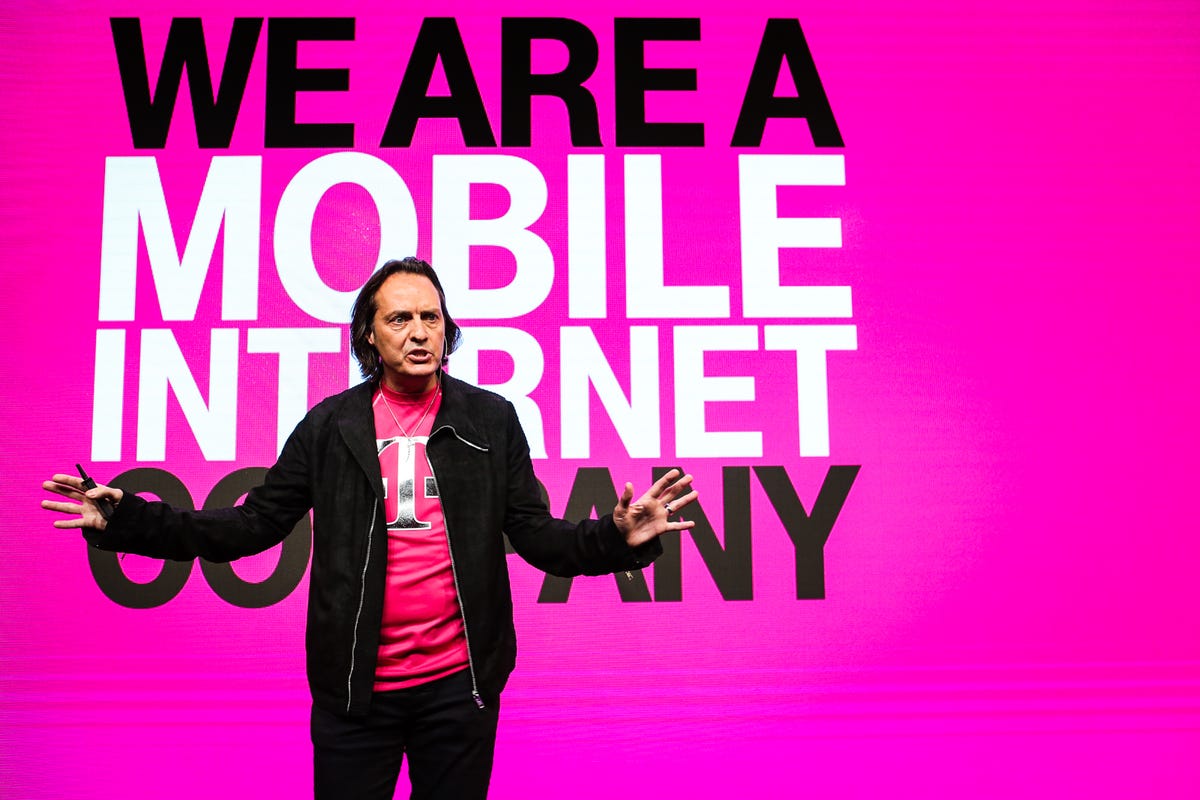
CNET/Sarah Tew
Wireless spectrum — the radio signals designated to carry data over the air from your smartphone to the Internet — isn’t the sexiest topic in the tech world.
But spectrum has a dramatic impact on the livelihood of the carriers, and that in turn affects the quality — and cost — of the wireless service you get at home, at work and out and about when you’re trying to binge-watch “Orange is the New Black” from Netflix on your smartphone.
It’s time to pay attention, because a large swath of spectrum is about to become available — in fact, the first auction of new wireless spectrum in six years is right around the corner.
The Federal Communications Commission is slated to hold an auction on November 13 for licenses to use spectrum under the designation of Advanced Wireless Service, or AWS-3 (which I’ll explain in a minute). Wednesday marked the application deadline for the auction, which should draw multibillion-dollar bids from most of the major wireless providers, including No. 1-ranked Verizon Wireless and No. 2 ranked AT&T.
Spectrum is often referred to as the lifeblood of the wireless industry because it is. More spectrum means faster and more-reliable wireless service. Spectrum is a limited resource controlled, for the most part, by the US government, and it can be obtained only through a government auction or by acquiring a company with spectrum holdings. Because more spectrum is necessary to handle the ever increasing amount of data traffic we’re consuming and sharing over smartphones, tablets and, increasingly, cars and other gadgets and machines, wireless carriers are going to fight for the spectrum they want.
CNET breaks down this year’s auction, gets you background on spectrum and fills you in on what changes to expect in your wireless coverage and when to expect them.
So what’s going on?
The FCC has been working for years to prepare the AWS-3 spectrum for auction. It’s been a complicated task because many government agencies — in particular, the Defense Department — already use those licenses for their own purposes, powering their own communications capabilities.
Related stories
- Wireless spectrum: What it is, and why you should care
- The coming wireless spectrum apocalypse and how it hits you
- Wireless spectrum shortage? What spectrum shortage?
- How politics inflame the ‘spectrum crisis’
But now there’s a plan in place to move these agencies on to other bands of spectrum, and that frees up AWS-3 for commercial use. And it’s not one continuous chunk; companies will bid on specific pieces of spectrum covering certain markets or big cities.
The auction is expected to generate a windfall for the government, with the FCC setting a reserve price of $10.5 billion. If the bids don’t exceed that amount, the government can stop the sale.
If the bidders do reach the reserve price, companies will have to go through several additional rounds of bidding before finalizing on a sale. In the last auction, the bidding went on for five rounds, with Verizon and AT&T winning the vast majority of the spectrum. The sale raised a total of $19.59 billion.
What’s spectrum again?
Don’t fret; this isn’t going to get too wonky. Wireless communications — data, phone calls and text messages — travel over the air via radio frequency. That’s similar to how you listen to a radio or pick up a television signal through an antenna.
Just like there’s spectrum dedicated to radio stations and television broadcasters, there’s spectrum specifically allocated for use by the wireless carriers. Because of the growing needs of the wireless industry, there are many different frequencies, or bands of spectrum, that are employed.
For this auction, there are three bands of spectrum available: the 1,695MHz to 1,710MHz band, the 1,755MHz to 1,780MHz band and the 2,155MHz to 2,180MHz band. All three blocks are considered “high band,” or at a frequency above 1,000MHz. That means they have a tougher time going through building walls. Conversely, they’re able to carry lots of data — imagine these wider-band blocks offering more lanes on the highway of wireless data.
That ability to carry lots of data is what makes these bands attractive to carriers, who are keen on finding a way to manage their wireless traffic. “This is addressing the continued phenomenal growth in data usage,” said Mark Lowenstein, consultant for Mobile Ecosystem.
Data usage has grown by fivefold over the past five years and is expected to triple over the next five years, according to network-equipment maker Cisco. Analysts consider that to be a conservative estimate.
(You can check out CNET Senior Writer Marguerite Reardon’s full explanation of wireless spectrum here.)
OK, what’s the big deal?
The auction is important on many levels. For the government, the auction is about revenue, since the spectrum is worth billions of dollars.
For the carriers, this is the first major sale since 2008’s 700MHz spectrum auction, which put carriers such as Verizon Wireless on the path to delivering its faster 4G LTE network.
“This auction is a culmination of a decade-long commitment with bipartisan support from members of Congress, the FCC, the administration, and the Department of Defense,” according to a statement by Meredith Atwell Baker, CEO of CTIA
, an industry trade group for the international wireless telecommunications industry.


CNET
Some of the carriers already use a different kind of AWS spectrum, which sits adjacent to the spectrum being auctioned off. Because of this, AWS-3 wouldn’t require a significant change in networking- and mobile-device equipment. AT&T and T-Mobile have long used AWS. Verizon Wireless uses both AWS and its 700MHz bands to power XLTE, the company’s nickname for its fastest service.
The new spectrum could potentially give smaller competitors, such as fourth-ranked T-Mobile, a chance to improve the quality of their network.
“Right now, you have two really strong carriers,” said Akshay Sharma, an analyst at Gartner. “This could bring in more competition.”
In addition, many countries in Europe use the same bands to power their LTE networks, so there’s the potential for more global harmony. For consumers, global harmony means they’ll be able to pick up on more bands, potentially improving their coverage and service.
Who are the major players?
Verizon Wireless, AT&T and T-Mobile are likely to buy up the bulk of available spectrum.
Another wild card is satellite-TV provider Dish Network, which has been steadily building up a war chest of spectrum. It’s unclear what Dish has planned with its wireless spectrum holding, but Lowenstein believes the company will eventually offer a fixed-mobile service as an alternative to DSL or cable to consumers in parts of the country that lack significant broadband infrastructure in the ground.


Josh Miller/CNET
Notably missing from the auction is No. 3-ranked Sprint. It’s sitting this auction out because it already has a large amount of high-band spectrum.
Verizon Wireless, AT&T, Dish and T-Mobile declined to comment.
How does this help me?
Depending on how the auction shakes out, Verizon, AT&T and T-Mobile could potentially deliver better service and handle more traffic with the additional spectrum. What that means is that you should be able to watch that streaming video from YouTube or play a real-time strategy game running on your cellular network with fewer hiccups.
Other industries stand to benefit, with cellular connections going into everything from health-monitoring equipment to security cameras to smart cars. All of that data will require a denser network.


Marguerite Reardon/CNET
Down the line, 4K video, also known as ultrahigh-definition video, will become the biggest bandwidth hog. Some smartphones, including the Sony Xperia Z3, already shoot 4K video with their camera, and it won’t be long before that video gets sent out over the mobile network as a stream. “That’s where we’re headed,” Sharma said.
High-band spectrum will be able to aid in the delivery of that video, particularly in large, densely populated cities. That’s why many expect bidding for spectrum in the larger cities to jump quickly.
For carriers, having more universal bands could mean they could run their networks on cheaper equipment and devices. That in turn could trickle down and lead to less-expensive smartphones for consumers.
Great. But how long until these benefits show up?
It depends. It was about two years between when the 700MHz auction wrapped up and when Verizon Wireless rolled out its first LTE market — and the carrier was on an accelerated scenario.
It’s likely that the carriers will take two to three years to upgrade their networks and devices to fully take advantage of the new spectrum. Hillol Roy, a consultant for IBB Consulting, said that the improvements to equipment-upgrade processes could take from that long down to a year, or even less.
But for a large chunk of the spectrum, it’s not that simple.
What are the complications?
The Defense Department continues to use the spectrum, and while there’s a plan for the agency to move, it’s expected to be two to three years before the carriers can even touch the spectrum.
“I wouldn’t hold my breath,” Sharma said.
Is there any more spectrum?
It’s funny you ask. After a six year gap between big spectrum auctions, there will be two in two years. In 2015, the FCC expects to hold an auction for spectrum in the 600MHz frequency.
The 600MHz spectrum will be sold off at the Incentive Auction, so named because a portion of the funds will go to the broadcasters who currently hold the spectrum and are being given an incentive to participate in the sale.


CNET
“The AWS-3 and upcoming Broadcast Incentive Auction are vital to continuing to meet Americans’ demands for mobile Internet and providing the US wireless industry with the spectrum necessary so it may remain the world’s best to deliver new and exciting services to all Americans,” Baker said.
The 600MHz band is considered more valuable because the lower band can stretch further and cover more people using less equipment. Telecommunications executives have in the past referred to the similarly low-band 700MHz swath as “beachfront property,” and have similar views on the incentive auction.
The only catch is that no other carrier uses 600MHz spectrum, which means network-equipment makers and mobile-device manufacturers will need to come up with new chips and gear that are compatible with the band.
Given the intense interest in the auction, that shouldn’t be a problem. Another reason Sprint isn’t participating in AWS-3 is because it wants to save up for the Incentive Auction. There’s some gamesmanship as the carriers attempt to jockey for the best AWS-3 auction but also save funds for the 600MHz swath.
“I definitely expect to see more-surgical bidding,” Roy said.



